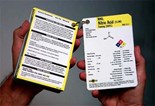A Graphics Design Approach to Lab Safety

The Background
Description
Other Hazard Warning Products
The Background (Back to Top)
Of course, the idea of posting the MSDS in a prominent place in a lab is hardly the newest concept around. But as Bevan D. Suits, director of design and development at Graphics Lab, points out, most of these sheets are way too detailed for emergency use; in fact, they're so detailed that most lab personnel ignore them. In general, he tells Laboratory Network.com, "people in labs tend to have a sense of overconfidence in themselves in terms of the way they would respond to emergencies." In reality, he adds, laboratory professionals often lose their cool in unexpected mishaps. Making safety information instantly available in a prominent place, he believes, can enable lab personnel to act decisively in a dire situation.

MSDS sign cards condense safety information into an easily visible and accessible format. (Source: Graphics Lab)
The new sign cards are designed so that the information on them is both easily visible and accessible. "What we're offering is a condensed form of MSDS sheets," Suits says. These can be hung from a metal ring at eye level or placed in the pocket of a lab coat, he notes. They also fit into the slots of a rack in stockrooms so that laboratory workers can pick up the cards when they remove reagents from the stockrooms.
Description (Back to Top)
The first batch of MSD Sign Cards, as Graphics Lab calls the new products, focus on the 100 most hazardous compounds that are commonly used in laboratories. The name of each chemical is printed at the top of each card in large black lettering on a yellow background. Underneath that is a table of the compound's hazards, its structural formula, lists of physical properties, reactivity properties, fire and explosion hazards, storage and handling information, and fire extinguishing tips. Also on the front is the NFPA diamond, a widely recognized symbol that summarizes a compound's hazard level and serves as a guide for emergency personnel. On the back of each card, which is printed on a chemically resistant synthetic paper stock, are further categories of information for each compound: prevention and first aid, health effects, spill scenario, and waste disposal.
The unique design logic for communicating hazardous chemical information was created by Afshin Ahangar, a trained chemist and author of the sign cards. The cards were co-developed by Suits, who holds a degree in industrial design, and Afhangar, who is manager and director of technical development for Graphics Lab. According to Suits, Graphics Lab has formed a partnership with William Andrew Publishing (Norwich, NY) to market the new sign cards, which should be available by mid-summer. The price of the cards is still being determined, he notes. The cards will be offered to industrial, academic and other research facilities. Customers will be able to pick and choose the specific cards they need to meet their needs.

Cards can be hung at eye level of laboratory personnel. (Source: Graphics Lab)
Other Hazard Warning Products (Back to Top)
Beyond the MSDS cards, Graphics Lab has just developed additional offerings to alert laboratory people to hazards. Among these products:
- An aluminum-framed 8 ½ by 11-inch window display sign, called the Lab Hazard Sign Frame, that allows lab managers to change safety information as new conditions arise. Information, which is typically posted outside a lab door, is entered with a grease pencil on an acrylic surface.
- A modular frame and window system for displaying paper sign graphics in corridors outside of lab doors. Again, the main purpose of the product, called the Window Grid Display System, is communicating health and safety information. Paper signs, typically produced on office printers, can slip easily into and out of the module.
- A clear, vinyl-tabbed book with 11 by 17-inch pages that allows managers to condense information in their safety manuals and post it at eye level of lab personnel. The product, called Life and Safety Sign Book, is sort of a cross between a standard safety manual and a warning sign.
For more information: Bevan D. Suits, Design and Development, Graphics Lab, 1382 Peachtree St. NE, Atlanta, GA 30309. Tel: 800-649-6488. Fax: 404-892-5823. Email: bevan.suits@perkinswill.com.
Also: Afshin Afhangar, Manager and Director, Technical Development, Graphics Lab, at same address, phone, and fax as above. Email: afshin.ahangar@perkinswill.com.
By Gordon Graff
